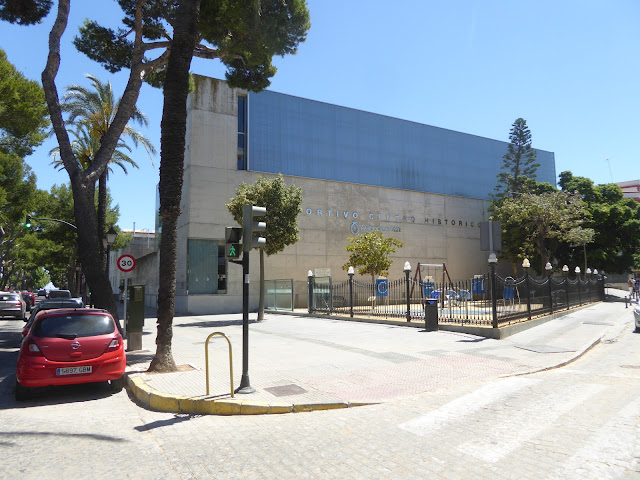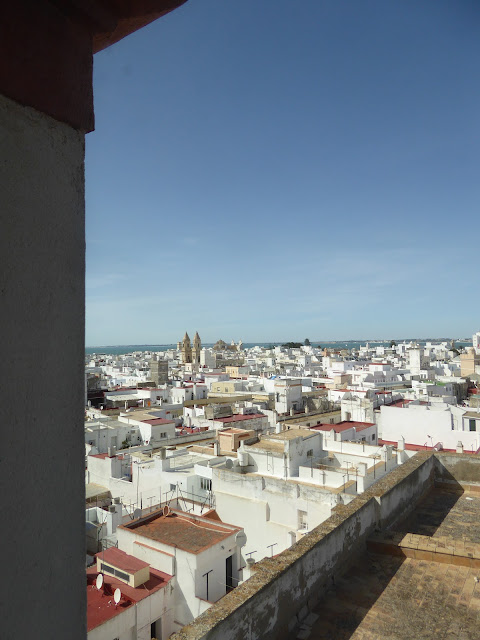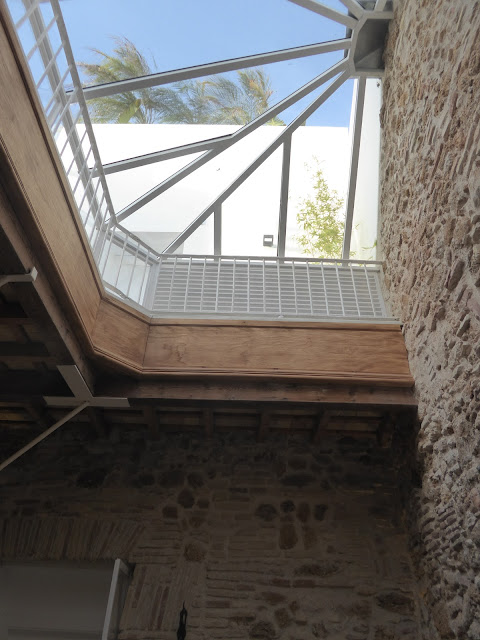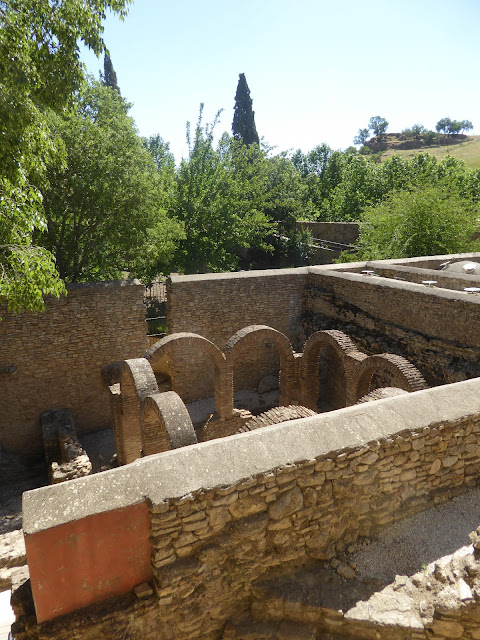CADIZ

"Cadiz is a city and port in southwestern Spain. It is the capital of the province of Cadiz, one of eight (provinces) which make up the (Comunidad de Andalusia) the autonomous community of Andalusia...Cadiz, the oldest continuously inhabited city in Spain and one of the oldest in western Europe, was founded by the Phoenicians (1104 BC). Cadiz is sometimes counted as the most ancient city still standing in western Europe ...According to a 2016 census estimate, the population of the city of Cadiz was 118,919, and that of its metropolitan area was 629,054...In recent years, the city's population has steadily declined. Between 1995 and 2006, it lost more than 14,000 residents, a decrease of 9%."
(Wikipedia)
PANORAMAS
(Aerial view by others.)
Views from the
TORRE TAVIRA
(The Tavira "Watch" Tower)
The watchtowers of Cadiz are advertised as one of the most characteristic elements of Andalusian architecture. Generally, they were built in the 17th and 18th centuries when Cadiz was the official entrance port of all the arriving merchandise from America and the West Indies. Successful merchants decorated their houses with a watchtower. They had two functions: they were a place for recreation, and they were a place from which the traffic in the harbor could be observed. Around 1777, Cadiz had 160 watchtowers. Of these,126 are still standing. They are difficult to locate at street level and even more difficult to photograph. Even in the panoramas, they tend to dissolve into the overall scene. The Torre Tavira is a house museum with one of the highest tower elements in the city.
(See, www.Torretavira.com)
View from enclosed tower portion below the open roof.
An adjacent, but lower, highly ornamented watchtower exhibiting the
Almoravid and Almohad influence on the city.
STREET SCENES
TEATRO ROMANO DE CADIZ
(Roman Theater of Cadiz)
The "Balbi" Roman Theater, named after a family of nobility in Gades (the ancient name for Cadiz) closely aligned to Julius Caesar, was built during the 1st century BC and was one of the largest amphitheaters in the Roman Empire. The theater featured a cavea (Latin for "enclosure" referring to the seating sections of Roman theaters and amphitheaters) with a diameter of more than 120 meters and could house 20,000 spectators. It was abandoned in the 4th century and in the 13th century a fortress was built on its ruins.
The remains of the theater, which are partially excavated, were discovered only in 1980. It is one of the few Roman structures of ancient Hispania mentioned by classical authors, including Cicero and Strabo. Excavations in the site have also found remains of a quarter dating to the taifa period (a period of independently Muslim-ruled principalities in Al-Andalus - Moorish Iberia - after the collapse of the Umayyad Caliphate of Cordoba in 1031); Almohad houses (dating to the Berber Muslim movement and dynasty that conquered the Spanish and North African empire in the 12th century); and 17th century pits.
The remains of the theater, which are partially excavated, were discovered only in 1980. It is one of the few Roman structures of ancient Hispania mentioned by classical authors, including Cicero and Strabo. Excavations in the site have also found remains of a quarter dating to the taifa period (a period of independently Muslim-ruled principalities in Al-Andalus - Moorish Iberia - after the collapse of the Umayyad Caliphate of Cordoba in 1031); Almohad houses (dating to the Berber Muslim movement and dynasty that conquered the Spanish and North African empire in the 12th century); and 17th century pits.
The contemporary interpretation center now attached to the forum.
A restored Almohad house.
The conserved vomitorium.
An archaeologist's re-construction of the original stage and stage house.

The present-day backdrop. The facades of the buildings that have established themselves in the area of the stage over the millennia have been neutered as much as possible. The arches reveal portions of the original backdrop. It is a less-than-perfect solution as to how to present what must have been a spectacular setting. Perhaps, more will be accomplished in the coming years to even better showcase the site.
BUILDING TYPE - Courtyard Housing
Architects have traditionally studied building types, series of recurring ways of designing and constructing a specific kind of structure. In Cadiz it does not take a student of architecture to notice that there are a multitude of multi-family buildings that have the same parti: a small, somewhat narrow, highly ornamented entry with a wrought iron gate leading to a normally modest open courtyard around which are located individual living units stacked three or four stories high. The upper units are reached by staircases spilling into the courtyards.
I have not researched this housing. It certainly has a long history that can be traced back to the Almohad period (the Islamic occupation of southern Spain dating from 1062-1269, during which time Seville was the capital of the empire). The courtyard houses shown below are obviously from a later date, but they preserve and exhibit a very particular way of living. It is a building type that has been reproduced - sometimes closely approximating the original form, sometimes only with a barely noticeable gesture - in various parts of the United States, particularly in the Spanish Colonial Revival architecture of Southern California.
I was captivated.
Even in more humble residencias, this building type and its details adds another level of livability to the place.
IGLESIA CONVENTUAL DE SAN FRANCISCO
(Convent Church of San Francisco)
Founded,1566; Rebuilt, late17th century
THREE PLAZAS
...the first two of which are on this Google Earth view.
Plaza de Mina
"Located on the site of the former vegetable garden of the Francisan Monastery, the square was developed halfway through the 19th century to turn it into an area for the public...It has been one of the city's most popular leisure areas ever since. The houses surrounding this landscaped area create a highly representative example of Cadiz's bourgeois architecture of the 19th century (including the Museum of Cadiz, the birthplace of the famous composer from Cadiz, Manuel de Falla, and the home to the Cadiz Professional Association of Architects)."
(Tourismo.cadiz.es)
In the late afternoon, the plaza becomes a vast playground even though it does not have one piece of playground equipment. Parents relax on the multitude of benches scattered throughout. Couples and friends sit down for a coffee at one of many cafes. The requisite ice cream parlor has a line snaking onto the sidewalk. The noise is as loud as in a small, completely filled restaurant, but it is far from a nuisance. As evening arrives, the lights reveal an equally busy scene, just a bit quieter, but still very vibrant.
Plaza de San Antonio
"Originally built in 1656 on the site of a well that supplied water it became the city's main square. The church was completed in 1669. As the place where the Spanish constitution was proclaimed in 1812 it was renamed Constitution Square. It got its present name, after the church, in 1937 and is today protected as a historic site."
www.360cities.net
As you can see from the aerial shot (above), this square is located just a short distance from the Plaza de MIna and is approximately the same size. It could not be more different. The "walls" of this square are equally beautiful, filled with their own rich assortment of architectural facades befitting the plaza's long history. At some point in the city's modern-day urban planning, a subterranean parking garage was inserted underneath the square. This always limits what can be done above, regardless of what landscape architects profess.
The square was obviously re-paved, respectively, but the overall effect is of emptiness rather than life, even if these photographs are from a quiet Sunday morning at 10:00. (But why, then, is the church shuttered?) It makes for attractive architectural shots, but even as people began filling the few cafes on the edges and began wandering across the bleak square, there was no sense of "there" there. Perhaps, it is a place for 5,000 or 10,000 people to gather...

Iglesia de San Antonio
Plaza San Juan de Dios
Ayuntamiento de Cadiz (Cadiz City Hall)
"Cadiz City Hall was built in 1799 on the foundations of the previous city halls, in two different stages: the first, Neoclassical phase was begun in 1799 by Torcuato Benjumeda, and the second phase, the interior, is in the Isabelline style and was designed by Garcia del Alamo in 1861."
(www.saba.es)
MERCADO CENTRAL DE ABASTOS
(Central Market)
Orignial perimeter building, Juan Daura, 1838
Original central building, Juan Talavera, 1929 (demolished)
Restoration, renovation, and new central building, Carlos de Riano Lozano, 2010
Editorial comment: Less than convincing.
It did give me pause to think what I would have done differently.
Post office building in the background. (See, below.)
EDIFICIO DE CORREOS
(Post Office Building)
1925
Plaza de las Flores.
MUSEO DE CADIZ
(The Cadiz Museum)
SER: "To Be"
GALERIA DE EDIFICIO MIRADOR Y DE PROTECCIÓN DEL PARQUE GENOVÉS
(Panoramic Viewpoint and [Weather] Defense Structure at Genoves Park)
José Luis Bezos Alonso. Architect
2015
"...the structure is built on two levels: the inferior one, completely made of glass, has a pedestrian walkway on top of it so you can admire the beautiful view of the bay of Cadiz on one side and on the other the park and historical centre. In this way, the protective structure is not seen as a limit or barrier any more but more as a point of contact due to the connection created by the transparent boundary between the sea and the nature in the botanical park..."
(www.floornature.com)
Sure...Certainly better - a lot better - than what was there. On site, it is still somewhat fortress-like and designed in that bad, aggressively off-putting modern way with materials that are difficult to keep clean (the windows have what appears to be a permanent layer of grunge that creates more of a translucent, rather then transparent effect), that do not age well (some of the metal screeds and panels are already permanently dented), and that are magnets for graffiti taggers (see below).
It is also not particularly inviting, nor people-friendly: the couple I was with opted for a coffee close-by rather than doing the circuit. I am sure the architect saw this is as some sort of contrasting statement to the otherwise soft backdrop of the park. It is architecture that makes for good photographs and less than good places for people. On the other hand, there was a flamenco lesson underway on one of the ground planes(?), the blue one, as I walked around. The participants seemed very excited. Everyday life prevails.
The situation prior to 2015: a walled park separated from the water by a parking lot.
A really bad parking lot.
The kind of parking lot where the world-known street artist Bansky suggested there could be something better by editing the existing signage.
The competition-winning plan for the structure.
...and the plan to re-establish the shore-front for recreational purposes.
The promotional aerial view of the completed project.
...and the promotional night view.
(My photogrpahs)
PARADOR CADIZ
Renovation of an existing structure by Collarte Architects Studio, 2012


POLIDEPORTIVO DEL CENTRO HISTORICO /
INSTITUTO MUNICIPAL DE DEPORTE
(Municipal Sports Institute and Gymnasium)

TWO HOTELS

JEREZ DE LA FRONTERA

Jerez, as it is popularly known, was for us a three-hour stopover on the way to Ronda. The city's history goes back to he third millennium BC, Jerez later became a Roman city, Asta Regia. Its old quarter surrounds the Alcazar de Jerez, a Moorish fortress founded in the 11th century. One source attributes the beginning of flamenco singing to Jerez. Today, the city is probably best known for its sherry wineries, all of which are open to the public. Statistics: As of 2015 the city, the largest in the province, had approximately 213,000 inhabitants. "It has become the transportation and communications hub of the province, surpassing even Cadiz, the provincial capital, in economic activity."
ALCAZAR DE JEREZ
11th century
(NOTE: Do not visit on a Sunday afternoon:
Everything is closed, sealed tightly shut to any untoward advances by marauding tourists.)
The somewhat more inviting, but still locked entrance.
STREET SCENES
PLAZA DEL ARENAL


PLAZA DE LA ASUNCION
Cabildo Viejo (Old Town Hall / House of the Cabildo)
Andres de Ribera, Diego Martin de Oliva, Bartolome Sanchez
1575
Iglesia de San Dionisio
(Church of San Dionisio)
Late 15th century
Interior Renovation, 18th century by Diego Antonio Diaz and Pedro de Silva
CATEDRAL DE JEREZ DE LA FRONTERA
COURTYARD HOUSES
...in the Cadiz mode (see, above)
MERCADO CENTRAL DE ABASTOS DE JEREZ
(Central Market)
IGLESIA DE SAN MIGUEL
(Church of San Michael)
IIIIIIIIIIIIIIIIIIIIIII
RONDA
Ronda is a mountaintop city in the Malaga province of Andalusia that is set dramatically above a deep gorge that carries the Rio Guadalevin through its center. This gorge (El Tajo) separates the city's circa-15th-century "new" town from its old town, dating to Moorish rule. The two parts of the town and their equally famous escarpment and views are connected by three bridges:
- Puente Romano ("Roman Bridge," also known as the Puente San Miguel)
- Puente Viejo ("Old Bridge," also known as the Puente Arabe or "Arab Bridge")
- Puente Nuevo ("New Bridge")
The Puente Nuevo is actually fairly recent in the scheme of things: the building of the bridge commenced in 1751 and took until 1793 to complete. The bridge is the tallest and most dramatic of the three, towering 120 m (390 ft.) above the canyon floor.
American artists Ernest Hemingway and Orson Welles spent may summers in Ronda as part-time residents of Ronda. Both wrote about Ronda's beauty and famous bullfighting traditions. Their collective accounts have contributed to Ronda's popularity over time. In the first decades of the 20th century, the famous German poet Rainer Maria Rilke spent extended period in Ronda.
The former town hall, which sits next to the Punete Nuevo, is the site of a national parador hotel. The population of the city is approximately 35,000.
(See, www.andalusia.com and Wikipedia)
THE ESCARPMENTS AND EL TAJO GORGE

(Early morning)
(Late afternoon)
PUENTE NUEVO
(The New Bridge)
Looking towards the new town.
Looking towards the old town.
STREET SCENES
PLAZA DUQUESA DE PARCENT
Parroquia Santa Maria la Mayor (Parish Church of Santa Maria la Mayor),
Ayuntamiento (City Hall)
Iglesia María Auxiliadora (Church of Mary
Help of Christians)
Founded by the Salesians
(Footnote)
Obama's Devotion to the Virgin Mary: Who Knew?
POLITICS DAILY I 9/28/2010 I David Gibson
Somehow this slipped past the Disputations filter, but during her vacation in Spain in August, First Lady Michelle Obama revealed that her husband -- a.k.a. President Obama -- "always carries a picture of Mary Help of Christians in his wallet."
Mary Help of Christians is the patroness of the Salesian order of priests and nuns, and during an Aug. 13 visit to the Spanish city of Ronda with her daughter, Sasha, the first lady stopped at the Salesian community there.
According to the Salesian news service she told the priest in charge that her husband "always carries with him a photograph with an image of Mary Help of Christians, to whom, those present reported, the first family of the United States has great devotion."
For Catholics, the special prayer to Jesus through his mother Mary for divine aid is about as, well, Catholic as you can get (evidence of a particular supplication to the Virgin dates back to the 3rd century, according to some sources). It is also more evidence for my colleague Jeff Weiss's theory that Obama is actually a closet Catholic and not a crypto-Muslim, as many believe.
But Obama's Marian devotion could resonate even more deeply, as the prayer to Mary Help of Christians is associated with two of the greatest battles in history between Christendom and Islam, both victories by papal forces.
The Virgin Mary was first formally given the title of "Help of Christians" by Pope Pius V after the dramatic naval victory over the Turkish forces at the Battle of Lepanto in 1571.
Then in 1683, the forces of Christendom beat back the 200,000 Ottoman Turks from the gates of Vienna. During the fighting, Emperor Leopold I of Austria took refuge in the Shrine of Mary Help of Christians at Pasau.
Many view those clashes as prequels to today's war between the West and radical Islam. The Blessed Virgin Mary to the rescue again?
PLAZA ESPANA
A WALK INTO EL TAJO GORGE
The Puente Viejo
BAÑOS ÁRABES
(Arab Baths)
13th-14th centuries
13th-14th centuries
Located at the base of El Tajo gorge.
IIIIIIIIIIIIIIIIIIIIIIIIIIII
_____________________________________
Copyright © 2017 Benjamin Clavan
















































































































































































































































